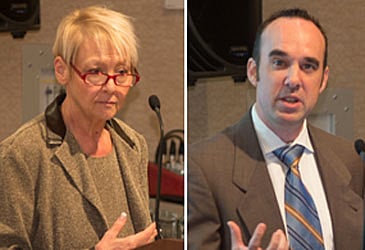While helping patients lead healthy lives is a primary goal of physicians, dramatic transformations aren’t always the result. But one patient with diabetes recently saw her health turn around as she lost more than 200 pounds with the help of her physician and lifestyle changes. She and her physician shared her story during a special session at the 2014 AMA Interim Meeting in Dallas.
Hosted by the AMA sections and special groups, the session provided an update on the AMA’s Improving Health Outcomes initiative, particularly its work in raising awareness of prediabetes and reducing the incidence of type 2 diabetes in the United States.
Local Dallas family physician Christopher Berry, MD, explained how his work helped patient Brenda Jones, who weighed 350 pounds in 2009 and was diagnosed with type 2 diabetes.
At the time, Jones didn’t have consistent care—most of her care was through emergency rooms or 24-hour clinics—and she eventually needed a motorized scooter to get around. Coming from a family of farmers who ate high-fat, high-sugar diets, she relied on insulin to keep her diabetes in check.
Jones found Dr. Berry through a local clinic. She felt that he was the first medical professional who really listened to and collaborated with her.
“Dr. Berry is good at treating my whole person,” she said. “I started telling him what I was thinking and feeling, and he simplified it for me. He gave me two things: Eat 2,000 calories a day, and keep a log. ‘Really?’ I thought. ‘That’s it?’”
With Dr. Berry’s help, Jones lost weight and was able to be taken off insulin injections. She learned about portion control and nutrition through community programs.
“Doctors need to realize how our culture that we come from affects us,” she said. She also pointed to how simple Dr. Berry made weight loss seem.
“It would be beneficial to not overwhelm the patient with a whole bunch of information—if you give too much, too fast, [we] just shut down,” she said. “If you could have five minutes of every visit and give a patient a recipe, some kind of nutritional advice, then maybe somebody is going to make a difference in their lives.”
To help physicians connect patients to community resources that can improve health, the AMA is working with the YMCA of the USA to explore a process for physicians to screen and test patients for prediabetes, refer eligible patients to participate in the local YMCA Diabetes Prevention Program, and receive feedback from the program to use in patients’ care plans.
The AMA is scaling its work to effect national change. Meanwhile, physicians like Dr. Berry are starting small to make important changes with patients in their communities.
“The truth is, we’re only going to see a slight percentage change in what the outcomes are in terms of the numbers,” Dr. Berry said. “It’s not going to be an enormous sea change, and that can be frustrating to physicians who want to see change. But what Brenda represents is how it does matter.”
Visit the Centers for Disease Control and Prevention’s National Diabetes Prevention Program Web page to learn whether a program is available in your community.




